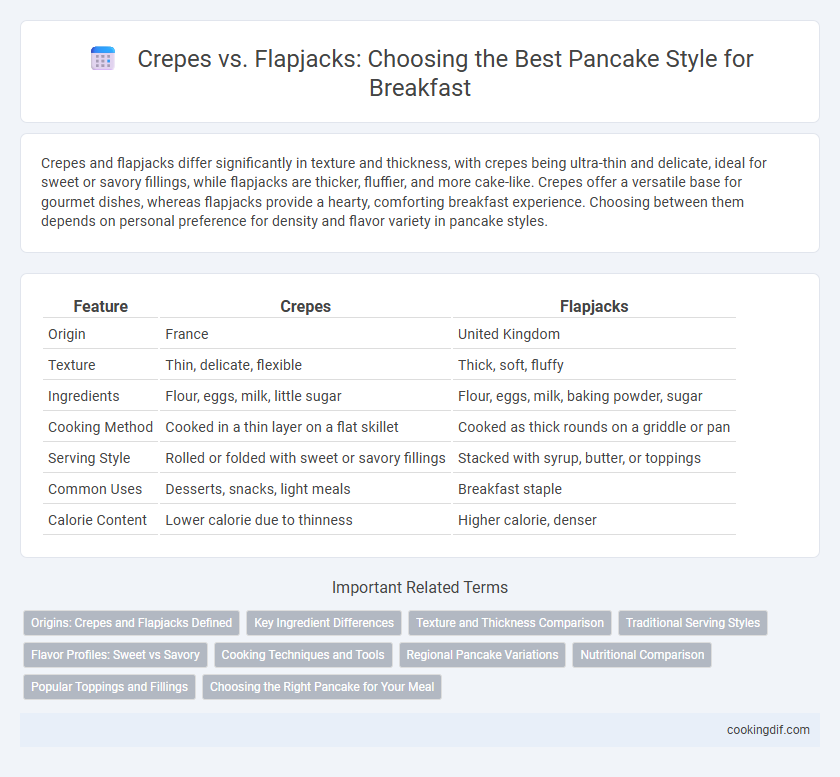Crepes and flapjacks differ significantly in texture and thickness, with crepes being ultra-thin and delicate, ideal for sweet or savory fillings, while flapjacks are thicker, fluffier, and more cake-like. Crepes offer a versatile base for gourmet dishes, whereas flapjacks provide a hearty, comforting breakfast experience. Choosing between them depends on personal preference for density and flavor variety in pancake styles.
Table of Comparison
| Feature | Crepes | Flapjacks |
|---|---|---|
| Origin | France | United Kingdom |
| Texture | Thin, delicate, flexible | Thick, soft, fluffy |
| Ingredients | Flour, eggs, milk, little sugar | Flour, eggs, milk, baking powder, sugar |
| Cooking Method | Cooked in a thin layer on a flat skillet | Cooked as thick rounds on a griddle or pan |
| Serving Style | Rolled or folded with sweet or savory fillings | Stacked with syrup, butter, or toppings |
| Common Uses | Desserts, snacks, light meals | Breakfast staple |
| Calorie Content | Lower calorie due to thinness | Higher calorie, denser |
Origins: Crepes and Flapjacks Defined
Crepes originated in Brittany, France, characterized by their thin, delicate texture made from a simple batter of flour, eggs, and milk. Flapjacks, a staple in American breakfast culture, are thicker and fluffier, leavened with baking powder or baking soda to create a soft, airy interior. Understanding these origins highlights the distinct culinary traditions that define crepes as French delicacies and flapjacks as classic American pancakes.
Key Ingredient Differences
Crepes use a thin batter made primarily from flour, eggs, milk, and a small amount of butter, resulting in a delicate, flexible texture ideal for folding with sweet or savory fillings. Flapjacks, commonly known as American-style pancakes, rely on a thicker batter that includes baking powder or baking soda for leavening, creating a fluffy and airy texture. The presence of leavening agents is the key ingredient difference that defines the distinct texture and thickness between crepes and flapjacks.
Texture and Thickness Comparison
Crepes feature a thin, delicate texture that is soft and slightly chewy, offering a smooth, pliable surface ideal for folding or rolling with fillings. Flapjacks, on the other hand, are thicker and fluffier with a spongier texture due to a leavening agent, providing a more substantial bite and a light, airy interior. The contrasting thickness and texture define the distinct eating experience between crepes' elegance and flapjacks' hearty satisfaction.
Traditional Serving Styles
Crepes are traditionally served thin and delicate, often rolled or folded with fillings like Nutella, fresh fruit, or sweet creams, highlighting their French origin. Flapjacks, thicker and fluffier, are typically stacked and topped with butter, syrup, or fruits, reflecting classic American breakfast culture. Both styles emphasize their distinct textures and toppings as key elements of their traditional serving methods.
Flavor Profiles: Sweet vs Savory
Crepes offer a delicate, thin texture with a subtle flavor that pairs well with both sweet fillings like Nutella and strawberries or savory options such as ham and cheese. Flapjacks, thicker and fluffier, emphasize a richer, buttery taste enhanced by ingredients like maple syrup or cinnamon, making them ideal for sweet breakfasts. While crepes excel in versatility between sweet and savory, flapjacks provide a hearty sweetness that defines classic pancake experiences.
Cooking Techniques and Tools
Crepes require a non-stick skillet or crepe pan and a thin batter poured evenly to achieve their signature delicate, paper-thin texture. Flapjacks use a thicker batter and a griddle or flat frying pan, cooked on both sides to produce fluffy, thick pancakes. Using a spatula designed for flipping helps maintain the structure and presentation of both styles during cooking.
Regional Pancake Variations
Crepes, originating from France, are thin pancakes made with a runny batter, often served with sweet or savory fillings and characterized by a delicate texture unique to European culinary traditions. In contrast, flapjacks in the United States refer to thick, fluffy pancakes made with baking powder, commonly enjoyed with syrup or butter, reflecting American breakfast culture. These regional pancake variations highlight distinct ingredients and preparation styles, emphasizing the diversity within global pancake recipes.
Nutritional Comparison
Crepes typically have fewer calories and less fat than flapjacks due to their thin batter and minimal oil use, making them a lighter pancake option. Flapjacks, often thicker and fluffier, contain more carbohydrates and protein from added ingredients like eggs and baking powder, catering to higher energy needs. Both pancakes provide essential nutrients like iron and B vitamins, but crepes are favored for lower calorie intake while flapjacks support greater satiety and muscle recovery.
Popular Toppings and Fillings
Crepes, known for their thin and delicate texture, are often filled with sweet options like Nutella, fresh berries, whipped cream, and lemon with sugar, while savory versions include ham, cheese, and spinach. Flapjacks, thicker and fluffier, favor toppings such as maple syrup, butter, fresh fruits, and sometimes caramelized nuts for extra crunch. Both pancake styles offer versatile topping and filling choices that cater to sweet and savory preferences, enhancing their appeal across different taste profiles.
Choosing the Right Pancake for Your Meal
Crepes and flapjacks offer distinct textures and flavors that influence meal pairing decisions. Crepes feature a thin, delicate structure perfect for savory fillings or light desserts, while flapjacks provide a thicker, fluffier base ideal for hearty breakfasts with syrup and butter. Selecting between crepes and flapjacks depends on the desired meal style, whether a refined snack or a filling morning dish.
Crepes vs Flapjacks for pancake style Infographic

 cookingdif.com
cookingdif.com